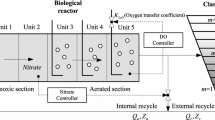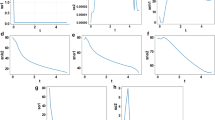Abstract
Wastewater treatment plays a crucial role in alleviating water shortages and protecting the environment from pollution. Due to the strong time variabilities and complex nonlinearities within wastewater treatment systems, devising an efficient optimal controller to reduce energy consumption while ensuring effluent quality is still a bottleneck that needs to be addressed. In this paper, in order to comprehensively consider different needs of the wastewater treatment process (WTTP), a two-objective model is to consider a scope, in which minimizing energy consumption and guaranteeing effluent quality are both considered to improve wastewater treatment efficiency To efficiently solve the model functions, a grid-based dynamic multi-objective evolutionary decomposition algorithm, namely GD-MOEA/D, is designed. A GD-MOEA/D-based intelligent optimal controller (GD-MOEA/D-IOC) is devised to achieve tracking control of the main operating variables of the WTTP. Finally, the benchmark simulation model No. 1 (BSM1) is applied to verify the validity of the proposed approach. The experimental results demonstrate that the constructed models can catch the dynamics of WWTP accurately. Moreover, GD-MOEA/D has better optimization ability in solving the designed models. GD-MOEA/D-IOC can achieve a significant improvement in terms of reducing energy consumption and improving effluent quality. Therefore, the designed multi-objective intelligent optimal control method for WWTP has great potential to be applied to practical engineering since it can easily achieve a highly intelligent control in WTTP.
Similar content being viewed by others
Reference
Zhao L, Dai T, Qiao Z, et al. Application of artificial intelligence to wastewater treatment: A bibliometric analysis and systematic review of technology, economy, management, and wastewater reuse. Process Saf Environ Protection, 2020, 133: 169–182
Wang D, Ha M M, Qiao J F, et al. Data-based composite control design with critic intelligence for a wastewater treatment platform. Artif Intell Rev, 2020, 53: 3773–3785
Rout P R, Zhang T C, Bhunia P, et al. Treatment technologies for emerging contaminants in wastewater treatment plants: A review. Sci Total Environ, 2021, 753: 141990
Han H G, Zhang J C, Du S L, et al. Robust optimal control for anaerobic-anoxic-oxic reactors. Sci China Tech Sci, 2021, 64: 1485–1499
Han H G, Liu Z, Hou Y, et al. Data-driven multiobjective predictive control for wastewater treatment process. IEEE Trans Ind Inf, 2019, 16: 2767–2775
Zhang L, Gao H, Kaynak O. Network-induced constraints in networked control systems—A survey. IEEE Trans Ind Inf, 2012, 9: 403–416
Belchior C A C, Araújo R A M, Landeck J A C. Dissolved oxygen control of the activated sludge wastewater treatment process using stable adaptive fuzzy control. Comput Chem Eng, 2012, 37: 152–162
Harja G, Nascu I, Muresan C, et al. Improvements in dissolved oxygen control of an activated sludge wastewater treatment process. Circuits Syst Signal Process, 2016, 35: 2259–2281
Chistiakova T, Wigren T, Carlsson B. Combined L2-stable feedback and feedforward aeration control in a wastewater treatment plant. IEEE Trans Contr Syst Technol, 2019, 28: 1017–1024
Hernandez-del-Olmo F, Gaudioso E, Nevado A. Autonomous adaptive and active tuning up of the dissolved oxygen setpoint in a was-tewater treatment plant using reinforcement learning. IEEE Trans Syst Man Cybern C, 2012, 42: 768–774
Zhang Z, Kusiak A, Zeng Y, et al. Modeling and optimization of a wastewater pum** system with data-mining methods. Appl Energy, 2016, 164: 303–311
De Keyser W, Amerlinck Y, Urchegui G, et al. Detailed dynamic pum** energy models for optimization and control of wastewater applications. J Water Clim Change, 2014, 5: 299–314
Wang Z, Hu C, Zhu Y, et al. Neural network learning adaptive robust control of an industrial linear motor-driven stage with disturbance rejection ability. IEEE Trans Ind Inf, 2017, 13: 2172–2183
Mesquita D P, Amaral A L, Ferreira E C. Estimation of effluent quality parameters from an activated sludge system using quantitative image analysis. Chem Eng J, 2016, 285: 349–357
Machado V C, Gabriel D, Lafuente J, et al. Cost and effluent quality controllers design based on the relative gain array for a nutrient removal WWTP. Water Res, 2009, 43: 5129–5141
Niu G, Yi X, Chen C, et al. A novel effluent quality predicting model based on genetic-deep belief network algorithm for cleaner production in a full-scale paper-making wastewater treatment. J Cleaner Production, 2020, 265: 121787
Guerrero J, Guisasola A, Vilanova R, et al. Improving the performance of a WWTP control system by model-based setpoint optimisation. Environ Model Software, 2011, 26: 492–497
Guerrero J, Guisasola A, Comas J, et al. Multi-criteria selection of optimum WWTP control setpoints based on microbiology-related failures, effluent quality and operating costs. Chem Eng J, 2012, 188: 23–29
Yin S, **e X, Sun W. A nonlinear process monitoring approach with locally weighted learning of available data. IEEE Trans Ind Electron, 2017, 64: 1507–1516
Santín I, Pedret C, Vilanova R, et al. Advanced decision control system for effluent violations removal in wastewater treatment plants. Control Eng Practice, 2016, 49: 60–75
Zhang Y, Gong D, Sun J, et al. A decomposition-based archiving approach for multi-objective evolutionary optimization. Inf Sci, 2018, 430–431: 397–413
Bilal, Pant M, Zaheer H, et al. Differential evolution: A review of more than two decades of research. Eng Appl Artificial Intelligence, 2020, 90: 103479
Hou Y, Wu Y L, Liu Z, et al. Dynamic multi-objective differential evolution algorithm based on the information of evolution progress. Sci China Tech Sci, 2021, 64: 1676–1689
Hsieh T J. Data-driven oriented optimization of resource allocation in the forging process using bi-objective evolutionary algorithm. Eng Appl Artif Intell, 2020, 89: 103469
**e Y B, Qiao J F, Wang D, et al. A novel decomposition-based multiobjective evolutionary algorithm using improved multiple adaptive dynamic selection strategies. Inf Sci, 2021, 556: 472–494
Qi Y, Li X, Yu J, et al. User-preference based decomposition in MOEA/D without using an ideal point. Swarm Evol Computat, 2019, 44: 597–611
Deng W, Xu J, Gao X Z, et al. An enhanced MSIQDE algorithm with novel multiple strategies for global optimization problems. IEEE Trans Syst Man Cybern Syst, 2020, doi: https://doi.org/10.1109/TSMC.2020.3030792
Deng W, Shang S, Cai X, et al. Quantum differential evolution with cooperative coevolution framework and hybrid mutation strategy for large scale optimization. Knowledge-Based Syst, 2021, 224: 107080
Gao X Z, Nalluri M S R, Kannan K, et al. Multi-objective optimization of feature selection using hybrid cat swarm optimization. Sci China Tech Sci, 2021, 64: 508–520
Deng W, Xu J, Zhao H, et al. A novel gate resource allocation method using improved PSO-based QEA. IEEE Trans Intell Transp Syst, 2020, 1–9
Chen C, You J, Feng H J, et al. A multi-objective study on the constructal design of non-uniform heat generating disc cooled by radialand dendritic-pattern cooling channels. Sci China Tech Sci, 2021, 64: 729–744
Deng W, Xu J, Song Y, et al. Differential evolution algorithm with wavelet basis function and optimal mutation strategy for complex optimization problem. Appl Soft Comput, 2021, 100: 106724
Li X, **ng K, Lu Q. Hybrid particle swarm optimization algorithm for scheduling flexible assembly systems with blocking and deadlock constraints. Eng Appl Artif Intell, 2021, 105: 104411
Deng W, Zhao H, Yang X, et al. Study on an improved adaptive PSO algorithm for solving multi-objective gate assignment. Appl Soft Comput, 2017, 59: 288–302
Qiao J F, Hou Y, Zhang L, et al. Adaptive fuzzy neural network control of wastewater treatment process with multiobjective operation. Neurocomputing, 2018, 275: 383–393
Hreiz R, Roche N, Benyahia B, et al. Multi-objective optimal control of small-size wastewater treatment plants. Chem Eng Res Des, 2015, 102: 345–353
Sweetapple C, Fu G, Butler D. Multi-objective optimisation of wastewater treatment plant control to reduce greenhouse gas emissions. Water Res, 2014, 55: 52–62
Beraud B, Steyer J P Lemoine C et al. Optimization of WWTP control by means of multi-objective genetic algorithms and sensitivity analysis. Comput Aid Chem Eng, 2008, 25: 539–544
Zhou A M, ** Y C, Zhang Q F. A population prediction strategy for evolutionary dynamic multiobjective optimization. IEEE Trans Cybern, 2014, 44: 40–53
Li S, Yang S, Wang Y, et al. A modular neural network-based population prediction strategy for evolutionary dynamic multi-objective optimization. Swarm Evol Computat, 2021, 62: 100829
Fan Q, Zhang Y, Li N. An autoselection strategy of multiobjective evolutionary algorithms based on performance indicator and its application. IEEE Trans Automat Sci Eng, 2021, 1–15
Wu X, Yuan Q, Wang L. Multiobjective differential evolution algorithm for solving robotic cell scheduling problem with batch-processing machines. IEEE Trans Automat Sci Eng, 2021, 18: 757–775
Ruan G, Yu G, Zheng J, et al. The effect of diversity maintenance on prediction in dynamic multi-objective optimization. Appl Soft Computing, 2017, 58: 631–647
Liang Z P, Wu T C, Ma X L, et al. A dynamic multiobjective evolutionary algorithm based on decision variable classification. IEEE Trans Cybern, 2020, 1–14
Gong D W, Xu B, Zhang Y, et al. A similarity-based cooperative coevolutionary algorithm for dynamic interval multiobjective optimization problems. IEEE Trans Evol Computat, 2020, 24: 142–156
Ding J L, Yang C E, **ao Q, et al. Dynamic evolutionary multi-objective optimization for raw ore allocation in mineral processing. IEEE Trans Emerg Top Comput Intell, 2018, 1–13
Feng L, Zhou W, Liu W, et al. Solving dynamic multiobjective problem via autoencoding evolutionary search. IEEE Trans Cybern, 2020, 1–14
Zhang K, Shen C, Liu X, et al. Multiobjective evolution strategy for dynamic multiobjective optimization. IEEE Trans Evol Computat, 2020, 24: 974–988
Jiang S, Yang S. A steady-state and generational evolutionary algorithm for dynamic multiobjective optimization. IEEE Trans Evol Computat, 2017, 21: 65–82
Zou J, Li Q, Yang S, et al. A prediction strategy based on center points and knee points for evolutionary dynamic multi-objective optimization. Appl Soft Comput, 2017, 61: 806–818
Jiang M, Wang Z, Hong H et al. Knee point-based imbalanced transfer learning for dynamic multiobjective optimization. IEEE Trans Evol Computat, 2021, 25: 117–129
Author information
Authors and Affiliations
Corresponding author
Additional information
This work was supported by the National Key Research and Development Project of China (Grant No. 2018YFC1900800-5), the National Natural Science Foundation of China (Grant Nos. 61773373, 6153302, 62021003, and 61890930-5), and Bei**g Natural Science Foundation (Grant No. JQ19013).
Rights and permissions
About this article
Cite this article
**e, Y., Wang, D. & Qiao, J. Dynamic multi-objective intelligent optimal control toward wastewater treatment processes. Sci. China Technol. Sci. 65, 569–580 (2022). https://doi.org/10.1007/s11431-021-1960-7
Received:
Accepted:
Published:
Issue Date:
DOI: https://doi.org/10.1007/s11431-021-1960-7




